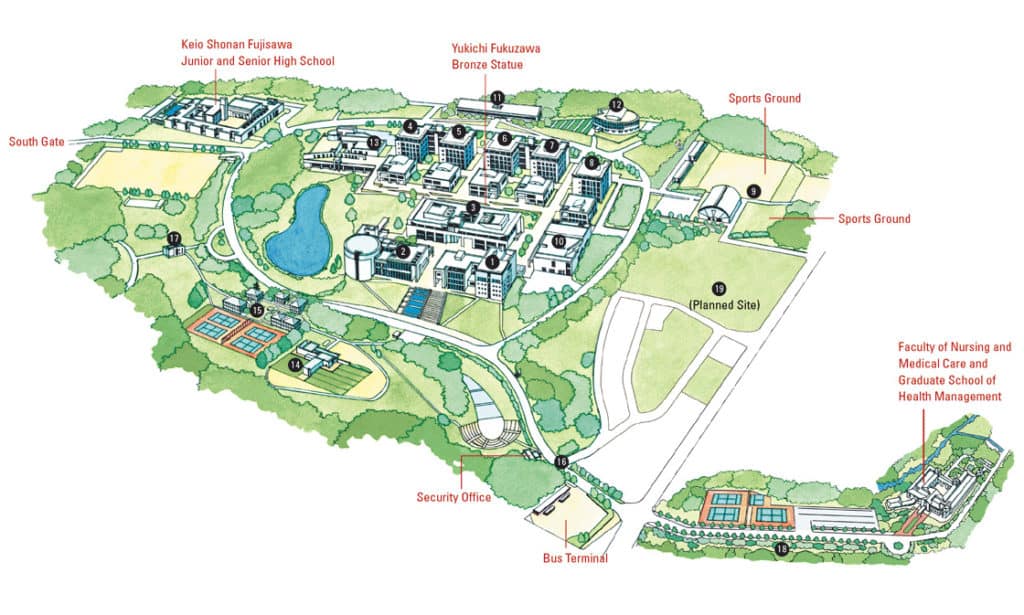SFC was the first university campus in Japan to develop and use its own integrated network system.
The Shonan Fujisawa Campus harmonizes technology and nature. Pritzker Laureate Fumihiko Maki designed the layout of the campus with the aim of preserving the existing topography and flora as much as possible, while producing the best learning environment for students. Much like an information network, educational and research facilities radiate out from the center of the campus to create a nexus linked by access ways. This framework allows individual buildings to retain their character, yet form a cohesive whole, mirroring the community of students and professors connected by SFC’s research initiatives.

1. Alpha Building
The Alpha Building is the administrative hub of the campus, where students come for information regarding classes, exams and reports. The Academic Affairs Office – which includes the Student Life and the Career Services sections – Wellness Center and deans’ offices are also located here.
2. Omega Building
Lectures for large classes are held in this building’s classrooms, each of which has a 100-inch screen for presentations.
3. Mu Building and Shonan Fujisawa Media Center
The focal point of the campus is the Mu Building, a four-story edifice that houses the Shonan Fujisawa Media Center. The center offers an extensive array of reference materials that contains more than 340,000 books, journal titles and audiovisual resources. In addition to this, it provides online services that allow students to remotely access more than 50,000 e-journals and e-books within its digital library. Students may also use the audiovisual equipment and studios at the center to prepare presentation materials for group projects and research work.
4-8. Kappa, Epsilon, Iota, Omicron and Lambda Buildings
These buildings contain classrooms and research labs for faculty members.
9. Gamma Building
A fully equipped gym, the Gamma Building features a training room with exercise machines and weights, specialized facilities for judo, kendo, volleyball, basketball, dance and table tennis, and locker rooms and showers.
10. Theta Building
This building houses the campus’ largest lecture hall, which has a capacity of 600 and a 250-inch projection screen.
11. Delta Building
This versatile building provides students and professors with the facilities to conduct a wide range of projects, including real-time analyses of the economy, and research and development of advanced technology.
12. Tau Building
The Tau Building is also called the Graduate School Building. Students of the Graduate School of Media and Governance use the upper floors for their projects. The building houses the Office of Research Administration, which supports research activities conducted at SFC.
13. Sigma Building
The Sigma Building serves as a gathering place for students, staff and faculty. Several cafeterias and cafes that serve a variety of Asian and Western-style dishes, and a co-op store can be found here.
14. Seminar Guesthouse
Accommodations for guests, faculty and staff are available here.
15. Nu Buildings
Researchers conduct joint projects with businesses and government organizations in these five cottage-like buildings.
16. North Gate and Tallow Slope
The main entrance of Keio University SFC is the north gate, which leads students and visitors up a tree-lined slope to the heart of the campus.
17. Zeta Building
The Zeta Building houses common research laboratories. Students and professors carry out cutting-edge research projects here using advanced technology.
18. Keio Fujisawa Innovation Village
This business incubation facility, built in 2006, was designed to foster joint research with corporations, and encourage students and researchers to start new businesses. Prototype development offices are located within the building.
19. “Miraisozojuku” (Institute for Designing the Future)
Aiming to become a global gateway of Keio University, the planned Miraisozojuku will be a hub for promising students and researchers from around the world to live and study together as they tackle global-scale issues. Activities at the best residential education and research facility in Japan will include collaboration with companies and other universities.
